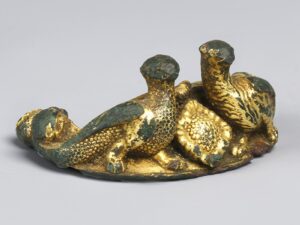Bactria was a historical region in Central Asia, covering areas of modern-day Afghanistan, Uzbekistan and Tajikistan. The object belongs to a large class of compartmented seals, characteristic of this region. The stamps were frequently produced in either copper or bronze and would feature distinctive figural or geometric patterns such as floral and cross motifs, or animals such as goats, snakes, scorpions and mythical beasts. These designs would be pressed into clay or wax and were often found on pottery, largely acting as identification of ownership.
Scholars disagree about their use, with suggestions that they were used for administrative control for production and were related to a well-organisanised trade system which involved transporting goods across long distances. Others suggest that they were symbols of power and property, or since large numbers have similar images, have been speculated to have the apotropaic features of amulets, protecting owners from evil rather than ownership.
By the 3rd millennium BC, stamp seals of this type were replaced with cylinder seals.



















